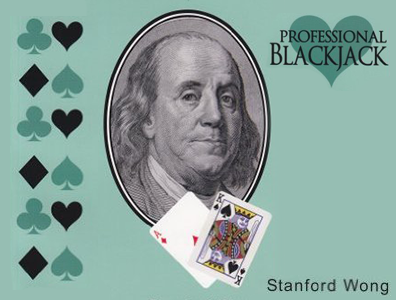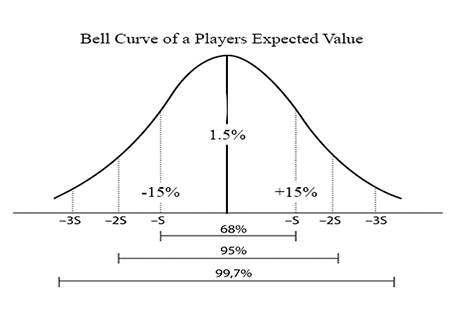Knowing When to Call it a Day

For professional and novice advantage players, a pressing question is how long should I play in any one session? Conventional wisdom states the longer you play the more money you will make. The most correct answer in this case is to play indefinitely. This is true because the more you play the more money you will put in play and thus win. For instance if the player is playing a game where they have a 1% advantage, it is easy to see that 1% of $100,000 in action is greater than 1% of $10,000 in action. Mathematically this is a logical argument. However, like many things in casino gaming, a better option is often counter intuitive to the initial perception. A pure mathematical argument cannot be adhered to because there are many things for an advantage player to consider while playing. Here we will explore contributing factors that determine a session’s length and ultimately derive a better mathematical approach to determining an optimal playing time.
Two contributing factors that determine how long an advantage player can play are betting levels and the bet spread. As our good friend Ben Affleck showed us it doesn’t matter who you are; a high level better with a huge bet spread will be barred from play. In 2014 Affleck spread one hand of $100 dollars to 3 hands of $20,000 dollars at a standard 3:2 blackjack shoe game. He was barred only a short time after trying to execute this not so subtle strategy. The successful player needs to play at levels consistent with the club they are in. Blending in is key. Reducing the bet spread is also a critical aspect of turning down the heat from the pit. But this can be complex because conventional wisdom states the gap between your low bet and your high bet significantly affects your advantage in the bet spreading approach.
The larger your bet spread the bigger your over all advantage is in a skill based game. Betting low in amounts in unfavorable situations and betting high amounts in favorable scenarios. In a standard betting pattern for an advantage blackjack player is the True count minus one system (T-1). This gives you how many units of your bankroll you should bet. The overall advantage for this system is approx 1%. The problem is that the bet spread can get very large. Particularly in a 6 deck shoe game the counts can exceed +20. And this almost certainly will attract the attention of the pit boss and surveillance operator.
A reduced bet spread will reduce your overall advantage but this will be more than compensated for by the increase in playing longevity. A bet spread that gives you good cover is should be as small as possible but large enough to give a decent win rate. This is usually determined by simulation. There are several programs that can do this. To compensate for the reduction in bet spread the player can use the adjusted index numbers that indicate at what remaining deck composition the player can deviate from basic strategy to increase the win rate. The most commonly known in blackjack, is the Illustrious 18 chart. It indicates the 18 plays where 80% of additional revenue from index plays comes from.

Another thing to consider is to know when to abandon a shoe and start on a new one. A technique commonly known as “Wonging,” after one of the forefathers of advantage Blackjack play Stanford Wong. “Wonging” levels are determined by the tolerance of the player. This is easier to execute when playing in online casinos than in land-based casinos because a player can feel pressured to come up with an excuse to change tables in land based casinos, but no reason need to be given in online casinos. This is an added benefit when playing in online casinos. Of course the best benefit from online play is the free money to play with. Most online gaming companies offer the player some initial free money to play with. 888casino is a very popular online casino where a new player receives a $200 sign up bonus and has a chance to win an additional $888 to play with. Free money is always a good thing, but more important to our discussion here is being able to freely change tables. There are so many games going on in online casinos that changing tables is not logistically difficult in the online realm.
Next we come to session lengths. A session length is dependent on a few different factors. In blackjack there are shoe games that consist of 4, 6 or 8 decks. There are also pitch games that are composed of 1 or 2 decks. Shoe games get less scrutiny than Double Deck games. And 3:2 full pay single deck Blackjack gets the most scrutiny of all games on a casino floor. Typically session length for a shoe game is approximately 90 minutes, which is anywhere between 100-200 hands depending on how many people are at the table. The Double Deck game session should be around 1 hour long, this translates into around 100-150 hands. And a single deck game session being 25-30 minutes in length with can be around 50 hands.
Other games are individual events that are not memory dependent. Roulette, Craps or 3 Card Poker the event odds are reset after the spin of the wheel, roll of the dice or shuffle of the deck. The session length depends on whether or not the advantage they are utilizing is present often enough to justify staying.
Gaming icon James Grosjean’s in his classic text Beyond Counting exhibit CAA, there is an article titled CTR Adverse Betting Report. Here Grosjean evaluates sub session lengths of 10, 25, 50 or 100 rounds. Depending on the amount being wagered Grosjean sets a win ceiling that is dependent on the table limits. The win ceiling is the strict amount at which a player stops playing when he hits the amount. He always assumes a $10,000 starting bankroll that is reinstated after every session. The objective here is to maximize profitably given the initial $10,000 bankroll and the session length.

I have based some of my analysis on the Grosjean report but other parts I have taken from other gaming icons. The win ceiling I have concluded is derived from Ken Uston’s book Million Dollar Blackjack. Uston’s analysis asserts that the most frequently win for a player occurs at 1.5% of the total bankroll. The Guassian distribution Curve below indicates the 1.5% peak with the appropriate standard deviations -15% to a +15% representing the limits of the lower and upper bounds of 1 standard deviation. Applying a 1/3 Kelly criterion of 700 units (this gives a 98% chance of success) we determine that the 1.5% win goal translates to a 10.5 unit per session. This is a strict win ceiling. This means the player stops playing at given table when the 10.5 unit thresh hold is reached or if the player has reached the session limit, whichever comes first. The central theme that governs this is that you will hit the 1.5% win ceiling a lot more times than you will lose the $10,000 session bankroll.
In summary reducing a bet spread reduces % advantage but this can be compensated in part by employing index plays for a given count system. Abandoning an overly negative remaining deck composition also helps. And the implementation of a session length and win ceiling is the most important application in knowing when to call it a day. In real world applications these methodologies have yielded a percent advantage that oscillates between 1.75% and 2.3% over 17,000 hands. This is in line with Monte Carlo simulations done over 400 million hands. And is ¾ % over a traditional T-1 system. These methods are insights into skill based gaming. More gambling halls are introducing games with a skill component. And this will offer increasing opportunities for these types of methodologies to be implemented.



